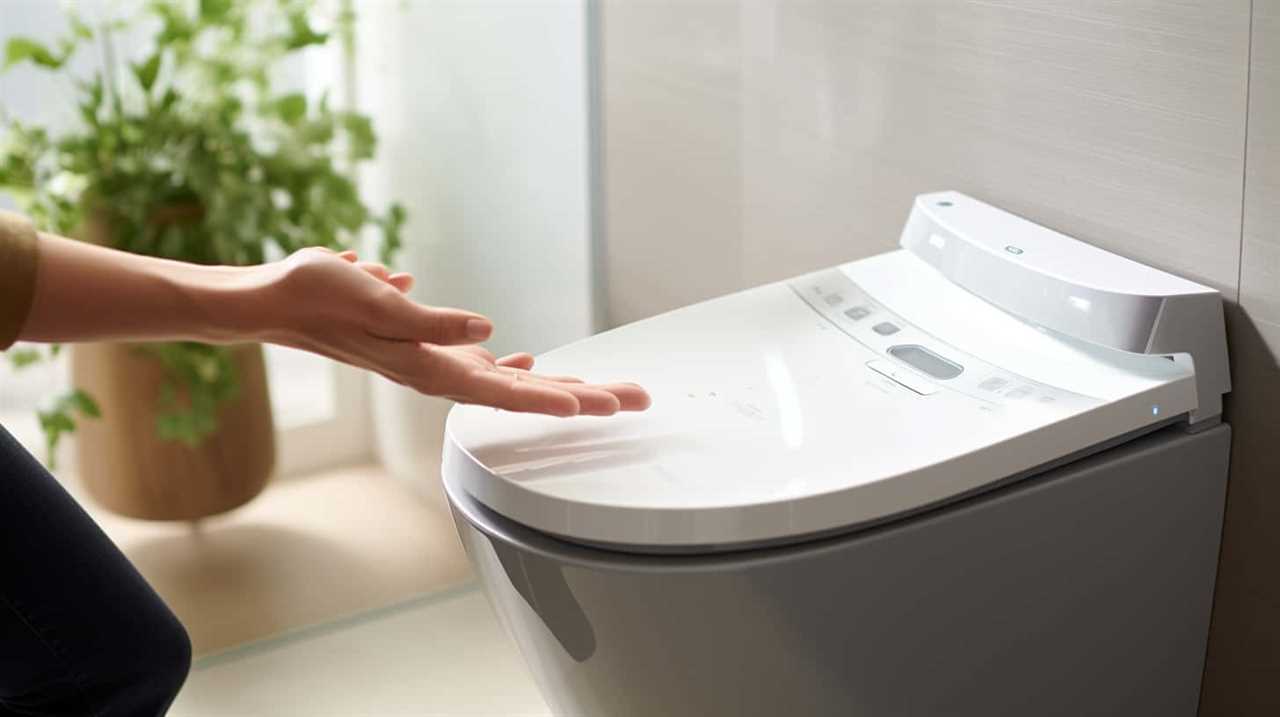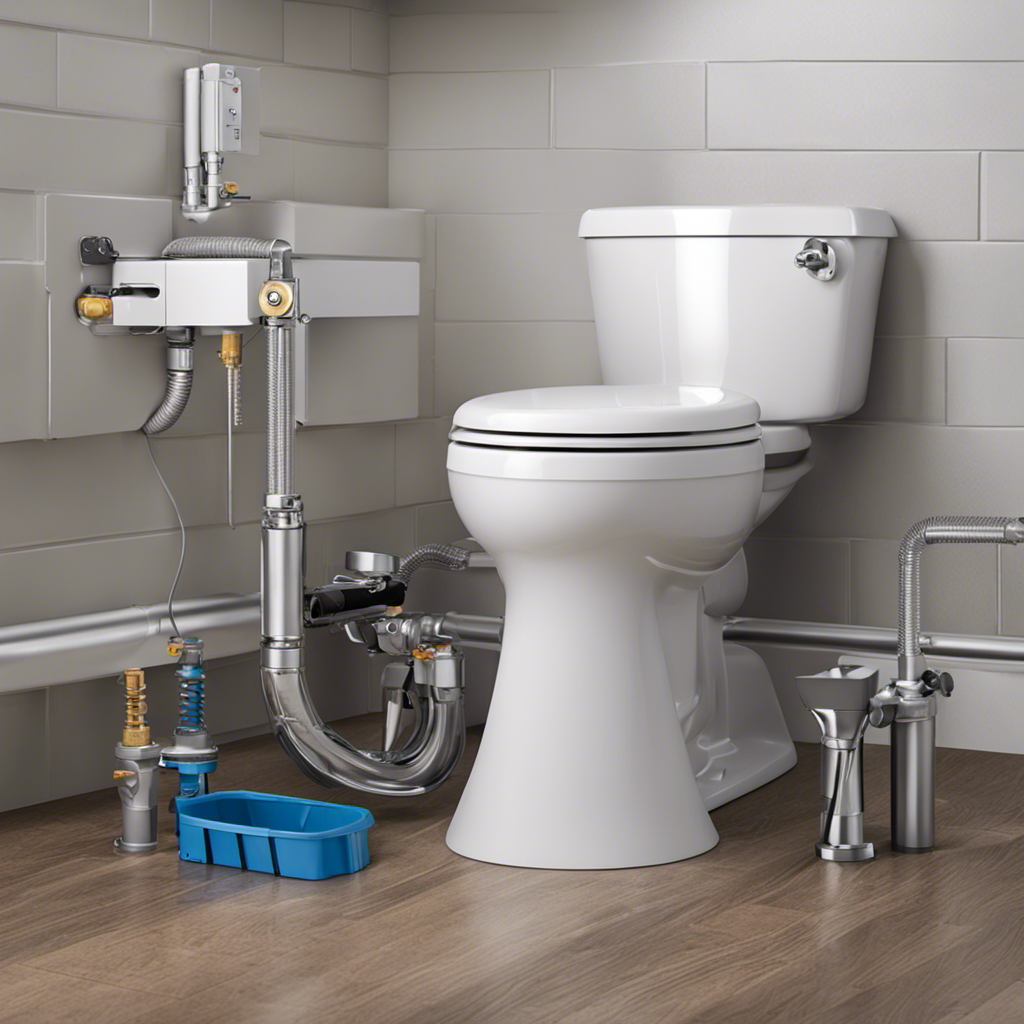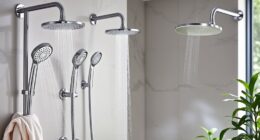Hey there! Ever been stuck in a sticky situation with a clogged toilet and no plunger in sight? Well, fear not! I’ve got you covered with some nifty tricks to flush your toilet without a plunger.
In this article, I’ll walk you through various methods that are both effective and easy to execute. From the bucket method to the wire hanger method, you’ll have a range of options to tackle this pesky problem.
So, let’s dive right in and save the day!
Key Takeaways
- The Bucket Method is a simple and effective way to flush the toilet without a plunger.
- The Hot Water Method can be effective, but caution must be taken to prevent accidents or injuries.
- The Vinegar and Baking Soda Method is a safe and environmentally friendly solution that can break down clogs.
- If other methods fail, alternative options include the Wire Hanger Method, Natural Enzyme Cleaner Method, or seeking professional help.
The Bucket Method
The bucket method is an effective way to flush the toilet without a plunger. It is a simple and non-plunger solution that can help resolve a clogged toilet.
To use this method, you will need a bucket filled with water. Start by pouring the water into the toilet bowl from a height of about waist level. The force of the water will create a strong flush, helping to dislodge any blockages in the pipes. Be careful not to overflow the toilet bowl while pouring the water. If the water level is too high, you can remove some of it using a cup or a bucket.
The bucket method is a quick and easy alternative to using a plunger, and it can be effective in most cases.
Now, let’s move on to the next non-plunger solution: the hot water method.
The Hot Water Method
When it comes to using the hot water method to unclog a toilet, it is important to take safety precautions to prevent any accidents or injuries.
- First, always make sure to wear protective gloves to avoid scalding your hands with hot water.
- Second, be cautious when pouring hot water into the toilet bowl to avoid splashing or overflowing.
- Lastly, keep a safe distance from the toilet while performing the hot water method to prevent any burns or mishaps.
In terms of effectiveness, the hot water method can be quite effective in unclogging a toilet. The hot water helps to break down and dissolve any blockages, allowing the water to flow freely again. However, it is important to note that the effectiveness of this method may vary depending on the severity of the clog.
Safety Precautions for Hot Water Method
Before attempting the hot water method, it’s important to take safety precautions. Here are some key steps to ensure hot water safety and prevent accidents:
- Always wear protective gloves to avoid burns.
- Use a bucket or container with a secure lid to transport the hot water.
- Be cautious when handling boiling water and keep it away from children and pets.
- Make sure the bathroom floor is dry and clear of any obstacles to prevent slips and falls.
Taking these safety measures will help minimize the risk of accidents while using the hot water method to flush your toilet without a plunger. Remember, safety should always be a top priority when attempting any DIY methods.
Effectiveness of Hot Water Method
To determine if the hot water method is effective, you should consider the temperature and amount of water used. The hot water method involves pouring a bucket of hot water into the toilet bowl in an attempt to dislodge the clog. This method is often seen as a safer alternative to using a plunger, as there is no risk of splashing water or damaging the toilet. However, its effectiveness may vary depending on the severity of the clog and the type of material causing the blockage.
In some cases, the hot water method may not be enough to completely clear the clog. For more stubborn clogs, it is recommended to try other methods such as using a vinegar solution or natural enzyme cleaners, which can provide additional benefits in terms of breaking down organic matter and eliminating odors.
Transitioning into the subsequent section about the vinegar and baking soda method, let’s explore how this combination can help unclog your toilet effectively.
The Vinegar and Baking Soda Method
When it comes to dealing with a clogged toilet, there are several alternative solutions to using a plunger.
One effective method is the vinegar and baking soda approach. By combining these two household ingredients, you can create a chemical reaction that helps break down the clog and clear the toilet.
Vinegar and Baking Soda
Mix vinegar and baking soda to create a powerful solution for unclogging a toilet without a plunger. Vinegar has numerous benefits, including its natural antibacterial properties and ability to dissolve mineral deposits. Baking soda, on the other hand, is known for its versatile uses, from cleaning and deodorizing to acting as a mild abrasive. When combined, these two ingredients create a chemical reaction that can help break down clogs and clear the toilet drain.
Here are four reasons why this method is effective:
- The fizzing action helps to dislodge the blockage
- Vinegar’s acidity helps dissolve organic matter
- Baking soda’s abrasive properties help break apart the clog
- The solution is safe and environmentally friendly
Plunger Alternative Solution
After trying the vinegar and baking soda method without success, I started searching for other alternatives to unclog my toilet. Two methods that caught my attention were the plastic bag method and the toilet brush method.
The plastic bag method involves placing a plastic bag over your hand and using it to create a seal around the drain. Then, you simply push and pull the bag in a pumping motion to create pressure and hopefully dislodge the clog. This method can be effective for minor blockages.
On the other hand, the toilet brush method requires a bit more effort. You need to insert the toilet brush into the drain and gently maneuver it back and forth to break up the clog. This method is more suitable for larger and stubborn obstructions.
Both methods require caution and proper hygiene practices. Make sure to wear gloves and thoroughly clean and disinfect the plastic bag or toilet brush afterward.
The Soap and Water Method
To use the soap and water method, you’ll need to gather some liquid soap and hot water. This method is a simple and effective way to unclog a toilet without the need for a plunger.
Here are the advantages of using the soap and water method:
- It is a cost-effective solution as you only need basic household items.
- The soap helps to lubricate and break down any blockage, making it easier to flush.
- Hot water helps to dissolve any solid waste and increases the effectiveness of the soap.
- This method is environmentally friendly as it does not involve the use of chemical drain cleaners.
To unclog the toilet using this method, pour a generous amount of liquid soap into the bowl followed by hot water. Let it sit for a few minutes to allow the soap to work its magic. Then, flush the toilet. Repeat the process if necessary until the clog is cleared.
The Plunger Alternative Method
If you don’t have a plunger, you can try using the baking soda and vinegar method to unclog your toilet. This is one of the most effective plunger alternative options for unclogging your toilet. The combination of baking soda and vinegar creates a chemical reaction that can help break down the clog and clear the pipe. Here is a simple step-by-step guide for using this method:
| Materials Needed | Instructions |
|---|---|
| Baking soda | 1. Pour 1 cup of baking soda into the toilet bowl. |
| Vinegar | 2. Slowly pour 1 cup of vinegar into the toilet bowl. |
| Hot water | 3. Let the mixture sit for about 30 minutes. |
| 4. Flush the toilet with hot water. |
This plunger alternative method can be a lifesaver when you don’t have a plunger on hand. Give it a try and see if it helps unclog your toilet effectively.
The Wire Hanger Method
The wire hanger method is another effective way to unclog a toilet when you don’t have a plunger. Here’s how it works:
- Bend a wire hanger straight, leaving the hook intact.
- Insert the straightened end into the toilet drain.
- Gently push and twist the hanger to dislodge the clog.
- Be careful not to scratch the porcelain.
This method can be quite effective in breaking up stubborn clogs. However, it’s important to note that it may not work for all types of blockages, especially if the clog is located further down the pipe.
If the wire hanger method doesn’t do the trick, don’t worry. There are other alternatives to try, such as the toilet brush method or the natural enzyme cleaner method.
Transitioning into the next section, let’s explore the benefits of using a natural enzyme cleaner to unclog a toilet.
The Natural Enzyme Cleaner Method
Using a natural enzyme cleaner can be an effective method for unclogging a toilet. These cleaners are designed to break down organic matter, such as hair, grease, and waste, that can accumulate and clog the pipes. I have personally used natural enzyme cleaners for toilet maintenance and found them to be highly effective.
One popular brand of natural enzyme cleaner is Biokleen Bac-Out. It contains a blend of live enzymes and bacteria that target and break down the organic matter. To use the cleaner, simply pour a generous amount into the toilet bowl and let it sit for a few hours or overnight. The enzymes will work to dissolve the clog, allowing it to be flushed away easily.
Here is a table summarizing the benefits of using natural enzyme cleaners for toilet maintenance:
| Benefits |
|---|
| Effective at breaking down organic matter |
| Safe for pipes and septic systems |
| Environmentally friendly |
| Easy to use |
Frequently Asked Questions
Can I Use Any Type of Bucket for the Bucket Method?
Yes, you can use any type of bucket for the bucket method. It’s a simple and effective way to unclog a toilet without a plunger. There are also alternative household items you can use.
How Much Hot Water Should I Use for the Hot Water Method?
When trying to unclog a toilet using hot water, it’s important to use enough to fill the bowl halfway. If hot water doesn’t work, you can try using a toilet auger or calling a plumber.
Are There Any Safety Precautions I Should Take When Using Vinegar and Baking Soda?
When using vinegar and baking soda to flush a toilet, it’s important to take safety precautions. Avoid inhaling the fumes, as they can be irritating. If you prefer alternatives, consider using a bucket of water or a toilet auger.
Can I Use Any Type of Soap for the Soap and Water Method?
Yes, you can use any type of soap for the soap and water method. It is an effective alternative method for flushing toilets, especially when a plunger is not available.
Is the Wire Hanger Method Safe for All Types of Toilets?
The wire hanger method can be used as an alternative to flushing the toilet without a plunger. It has its pros and cons, including the risk of scratching the toilet bowl.
Conclusion
In conclusion, when faced with a clogged toilet and no plunger in sight, there are several effective methods to try.
From the bucket method to the hot water method, each technique offers a unique solution to this common problem.
Whether using vinegar and baking soda, soap and water, or even a wire hanger, there is no need to panic.
With a little creativity and resourcefulness, you can unclog your toilet with ease, like a skilled plumber tackling a stubborn blockage.










